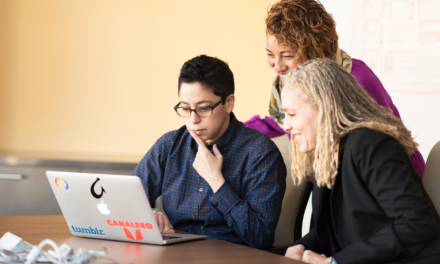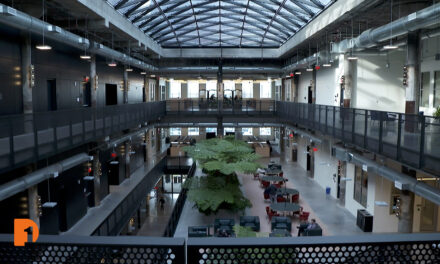In the past decade, the pulse of downtown Detroit has gone up and down like a rollercoaster. From a steep drop into bankruptcy a decade ago to swift twists and turns to return the city’s vibrancy, all for those efforts to be met with another huge drop— the COVID-19 pandemic. As Detroiters head into year three of the city’s post-pandemic recovery efforts, what plans are ahead? And what do the experts think?
One of the nation’s leading urbanists Richard Florida, co-founder of the Creative Class Group, sat down with One Detroit contributor, and “American Black Journal” host, Stephen Henderson after his keynote speech at the 2023 Detroit Policy Conference for a discussion about the future of downtown Detroit and how it compares to other urban cities.
Florida gives an assessment of where Detroit stands in its post-pandemic recovery today, comparing the city to other urban areas, and shares his thoughts about the ongoing shift toward remote and hybrid work models. Plus, he tells Henderson the two priorities downtown Detroit should be thinking about if it wants to recover successfully from the pandemic.
Full Transcript:
Stephen Henderson, Host of American Black Journal: Richard Florida, Welcome back to Detroit. I know this is one of your favorite places.
Richard Florida, Co-founder, Creative Class Group: Yeah, it’s kind of a second home for me since my wife’s family is basically from here.
Stephen Henderson: So let’s talk about Detroit post-pandemic. We are two years or almost three years since the bottoming out, I guess, of downtowns. Give me your assessment of Detroit. How are we doing and how are we doing compared to other cities?
Richard Florida: I mean, remote work has taken its toll on every downtown of any large metropolitan area in America. Overall, across the country, according to the best data we have about downtown, offices are about 50% filled. That ranges from Austin at the top, which is about two-thirds to the way back, at the very top. And then at the bottom, a place like San Francisco or Los Angeles is about a third, maybe 40% back. From what we know about Detroit, Detroit seems right about the average.
I think one thing that’s really interesting is, when you think about cities, it’s really the offices there aren’t back. People are going to movies, they’re going to restaurants, they’re going to hockey and basketball, and then football, and baseball games in the spring. Almost everything city is back except for the office. I think, in Detroit, the last time I looked, it was 85% back. In some Midwestern cities like Columbus, it’s actually over. It’s over 100% back. More people are back.
I think the real question is that… I don’t think we’re ever going to see the office come back the way it was. I think this has been an ongoing shift. And if you look at this trend of remote work, it did triple. But it had been going up before the pandemic. It hit about five or six percent of people working remotely. Now it’s about 18 percent, best figures we have. I mean, that still means 82% of the people go to the office sometime. But I don’t think it’s going to be Monday through Friday. I think it’s going to be a struggle.
Stephen Henderson: And it’s so different for us because we spent the ten years before the pandemic repairing a downtown that has lost all of its office energy. We had all of these empty buildings. People were not down there a lot. We really did double down on the idea that it should be a traditional downtown again. I think it’s a little more distressing for us that that investment and all that time, now, maybe needs to be retooled to do something different.
Richard Florida: I’ve been in and around downtown Detroit since the late seventies. I’m a kid from Newark, New Jersey. A downtown that was more troubled than Detroit at its worst moment. Look, I think the hard slog was what you did. The combination of deindustrialization, factory closures, loss of the economic function, and then you take suburbanization or white flight, whichever one you want to call it. De-industrialization and de-population devastated. There were a bunch of parking lots, a couple of buildings, and a lot of abandoned structures.
If you think about what happened here over the past decade, you’ve done a lot. I don’t think this is quite as bad. And really, I’ve now been studying the history of business, Central Business Districts. It’s not like they emerged in 1920 and stayed static. They have been invented- There’s a book. Robert Fogelson wrote this book around the year 2000 called “Downtown: Its Rise and Fall.” That was the sub-title. The rise and fall. And then we brought them back in the 2000s.
The downtown office work area is not going to be the same. But I think the downtown is an entertainment center, recreational center, and social center. I like to call it, not a central business district, but a central connectivity district. And then converting some into residences. I think that the more people who live downtown… One thing we found in the pandemic, neighborhoods in urban areas where people lived did better than ones where people just worked. So I think our next move is going to have to be creating more live. And the other one is, is making our downtowns more family-friendly, which is going to be another big challenge.
Stephen Henderson: Yes. And that was what I was going to ask. If we want to repopulate downtowns with residents, the way that we’re building right now doesn’t really do it. We’re building a lot of 500-square-foot studios, those kinds of things. If you have children, you want a two-bedroom, or maybe you want a three-bedroom. We have almost no three-bedroom apartments being built in downtown Detroit.
Richard Florida: And the same as in Philadelphia or Cleveland or even… Well, not so much Chicago and certainly not New York. But I think that in America, the downtown has been seen as either a place for the young, you know what I’m saying, kind of a hipster person who wants an urban experience, wants to go out, wants to meet other people, have friends, go on dates, or the empty nester whose kids have gone off and want to get rid of the big house and have a condo or an apartment.
Our downtowns, because of the legacy of not investing enough in our urban schools and because of the closure of many private and parochial schools that were in downtowns, they have a schooling deficit. So I think on the one hand, it’s bigger apartments, multifamily apartments that are family-friendly, that are not like, your kids can’t make noise and there’s no recreational room. But also reinvesting in schools.
I do think that’s one of the decent things New York City has done. New York City has done a pretty good job, not a perfect job of kind of upgrading schools and at least giving families urban schooling options. I think over time, if you ask me, as we repopulate our downtowns and build more residences, they’re not going to be fully repopulated or they’re not going to be balanced unless we can start to get more families back to the urban center.
Stephen Henderson: Well, here in metro Detroit, that bumps up against the other real issue we have which is inclusion and diversity. Making sure that, everybody feels like there’s an opportunity to participate in downtown. With housing, that seems doubly important.
Richard Florida: Yeah. And I mean urban centers bear more costs. One of the things that Detroit has been very good about is trying, not always succeeding, putting a focus on equity and inclusion. Whenever I’ve worked here or advised here, I’d say put equity and inclusion, inclusive development, and inclusive prosperity. The statistics are pretty grim, right?
Detroit city residents have half the median incomes of their suburban counterparts. I think it’s 27% live in a middle-class household versus 40% in the suburbs. And the really daunting one I saw in this Detroit Future City report, 5% of people in the city live in a middle-class neighborhood compared to, even if you have less income, 60% of the people in the suburbs live in a middle-class neighborhood with the kind of institutions. So the city has more cost, it has more poverty, more social services, has to invest more in schools. But I think this is the pivot we have to make as a society. And if we’re going to rebuild our cities, it’s either that or we’re not going to have cities that function.
So the next step in our cities is going to be they have to be more than just places for young people and empty nesters. More for just workforce commuters. They’re going to have to be rebuilt as more inclusive communities, with single people, with empty nesters, with workers and commuters, but with families.
Stephen Henderson: If you had to think of two things that maybe we’re not thinking of that we probably have to do in Detroit or in any downtown to keep getting over the pandemic and getting back to where we are, what would they be?
Richard Florida: I think just rethinking. The idea of a central business district, we have to get away from it. We know this. And if you look at where downtown is growing, it’s not just the central business district, it’s the Cass Corridor, it’s Corktown, it’s over near Eastern Market. All these areas. City after city, the downtown has kind of morphed out of business.
The hottest parts of New York, the hottest parts of Chicago are not the center core. So think about, not a central business district, but a central entertainment district, a central innovation district, a central what I call connectivity district, where people come to connect. The other one, I’d say… My mentor was a woman named Jane Jacobs. She wrote her first essay. She wrote many books later. Her first essay she wrote in 1951. Roughly, then. Over half a century ago. The title of that essay was not Downtown is for Offices. Downtown is for business. The title was Downtown is for People. I think that’s the key. Downtown is for people. We’ve been trying that for a half century. Now’s the time I think, we have to make it a reality.
Stephen Henderson: Richard Florida, it’s always great to have you here in Detroit and share your ideas with us. Thanks for being here.
Richard Florida: Thanks for having me.
Stay Connected:
Subscribe to One Detroit’s YouTube Channel & Don’t miss One Detroit Mondays and Thursdays at 7:30 p.m. on Detroit Public TV, WTVS-Channel 56.
Catch the daily conversations on our website, Facebook, Twitter @DPTVOneDetroit, and Instagram @One.Detroit
View Past Episodes >
Watch One Detroit every Monday and Thursday at 7:30 p.m. ET on Detroit Public TV on Detroit Public TV, WTVS-Channel 56.




